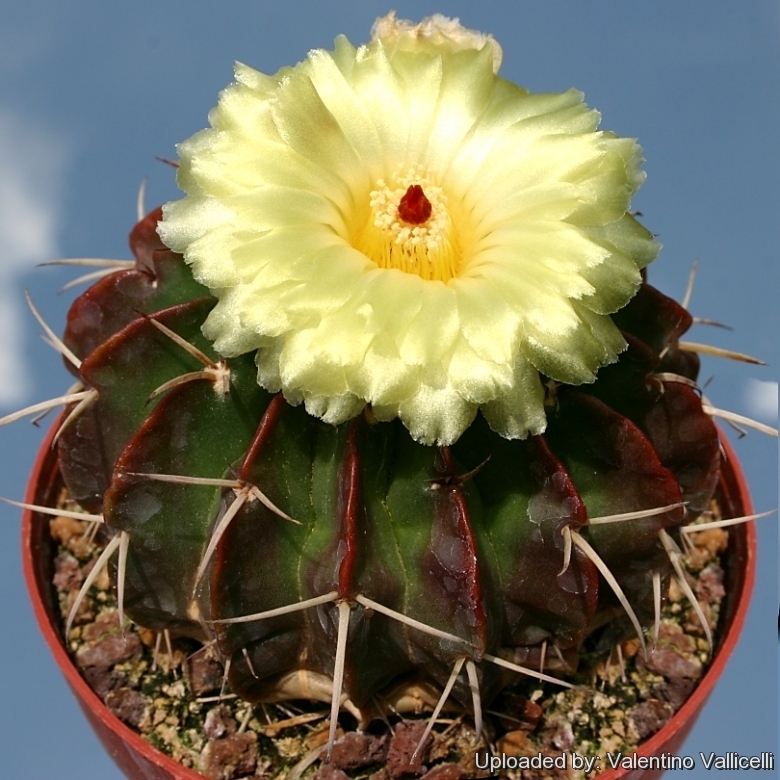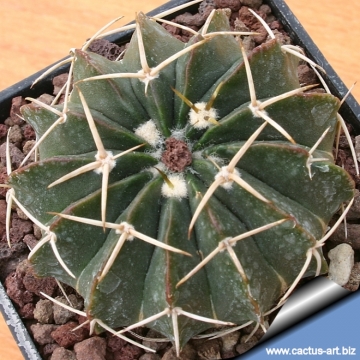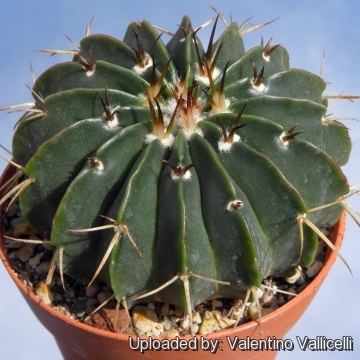




Your support is critical to our success.
Kaktus-ABC [Backeb. & Knuth] 252. 1936 [12 Feb 1936]
Family: CACTACEAE
= Wigginsia leucocarpa (Arechav.) D.M.Porter
Taxon 13: 211. 1964
Accepted Scientific Name: Parodia sellowii (Link & Otto) D.R.Hunt
Cactaceae Consensus Init. 4: 6. 1997 [Oct 1997]

This plant is recognizable for the metallic-grey to bluish‑gray stem that in full sun take a beautiful purple tinge. The flower are many petaled, the spines are few (usually 3) strong and long and the fruit is white.
Origin and Habitat: Uruguay (Southern South America, Southern America)
Synonyms:
- Wigginsia leucocarpa (Arechav.) D.M.Porter
- Malacocarpus leucocarpus (Arechav.) Backeb.
- Notocactus acuatus var. leucocarpus (Arechav.) Havlíček
- Notocactus leucocarpus (Arechav.) G.Schäf.
- Notocactus sellowii f. leucocarpus (Arechav.) N.Gerloff
Parodia sellowii (Link & Otto) D.R.Hunt
Cactaceae Consensus Init. 4: 6. 1997 [Oct 1997]
Synonymy: 109
- Parodia sellowii (Link & Otto) D.R.Hunt
- Echinocactus acuatus var. sellowii Speg.
- Echinocactus sellowii Link & Otto
- Echinocactus sellowii var. typicus Gürke
- Malacocarpus sellowianus Salm-Dyck
- Malacocarpus sellowii (Link & Otto) K.Schum.
- Melocactus sellowii Link & Otto
- Notocactus sellowii (Link & Otto) S.Theun.
- Wigginsia sellowii (Link & Otto) F.Ritter
- Parodia paucicostata (F.Ritter) F.H.Brandt ex Weskamp
- Wigginsia beltranii Frič ex Z.Fleisch. & Schütz
- Malacocarpus beltranii Frič
- Notocactus beltranii (Frič ex Z.Fleisch. & Schütz) G.Schäf.
- Notocactus sellowii var. beltranii (Frič) Neduchal
- Wigginsia bezrucii (Frič) Z.Fleisch. & Schütz
- Malacocarpus bezrucii var. Frič Frič
- Notocactus sellowii var. bezrucii (Frič) Neduchal
- Wigginsia bezrucii var. centrispina (Frič) Z.Fleisch. & Schütz
- Malacocarpus bezrucii var. centrispinus Frič
- Notocactus bezrucii var. centrispinus (Frič) S.Theun.
- Notocactus sellowii f. centrispinus (Frič) Neduchal
- Wigginsia corniger (Frič) Z.Fleisch. & Schütz
- Malacocarpus bezrucii var. corniger Frič
- Notocactus bezrucii var. corniger (Frič) S.Theun.
- Notocactus sellowii f. corniger (Frič) Neduchal
- Wigginsia bezrucii var. corniger (Frič) Z.Fleisch. & Schütz
- Wigginsia corynodes (Otto ex Pfeiff.) D.M.Porter
- Echinocactus acuatus var. corynodes (Otto ex Pfeiff.) Speg.
- Echinocactus corynodes Otto ex Pfeiff.
- Malacocarpus corynodes (Otto ex Pfeiff.) Salm-Dyck
- Notocactus acuatus var. corynodes (Otto ex Pfeiff.) Havlíček
- Notocactus corynodes (Otto ex Pfeiff.) Krainz
- Notocactus erinaceus f. corynodes (Otto ex Pfeiff.) N.Gerloff
- Wigginsia courantii (Lem.) F.Ritter
- Echinocactus courantii Lem.
- Echinocactus sellowii var. courantii (Lem.) Gürke
- Malacocarpus courantii (Lem.) Salm-Dyck
- Malacocarpus sellowii var. courantii (Lem.) Backeb. & F.M.Knuth
- Notocactus courantii (Lem.) S.Theun.
- Notocactus erinaceus subvar. courantii (Lem.) G.Schäf., G.Schäf.
- Notocactus sellowii var. courantii (Lem.) N.Gerloff
- Notocactus sellowii f. courantii (Lem.) N.Gerloff & Neduchal
- Wigginsia fricii (Arechav.) D.M.Porter
- Echinocactus fricii Arechav.
- Eriocactus fricii Arechav.
- Malacocarpus fricii (Arechav.) A.Berger
- Notocactus fricii (Arechav.) Krainz
- Notocactus sellowii f. fricii (Arechav.) N.Gerloff
- Wigginsia leucocarpa (Arechav.) D.M.Porter
- Malacocarpus leucocarpus (Arechav.) Backeb.
- Notocactus acuatus var. leucocarpus (Arechav.) Havlíček
- Notocactus leucocarpus (Arechav.) G.Schäf.
- Notocactus sellowii f. leucocarpus (Arechav.) N.Gerloff
- Wigginsia macracantha (Arechav.) D.M.Porter
- Echinocactus macrocanthus Arechav.
- Echinocactus sellowii var. macracanthus Arechav.
- Echinocactus sellowii f. macracanthus (Arechav.) Schelle
- Malacocarpus macracanthus (Arechav.) Herter
- Malacocarpus sellowii var. macrocanthus (Arechav.) Backeb. & F.M.Knuth
- Notocactus macracanthus (Arechav.) G.Schäf.
- Notocactus sellowii var. macracanthus (Arechav.) S.Theun.
- Notocactus sellowii f. macracanthus (Arechav.) N.Gerloff
- Wigginsia sellowii var. macracantha (Arechav.) F.Ritter
- Wigginsia macrogona (Arechav.) D.M.Porter
- Echinocactus macrogonus (Arechav.) Borg
- Echinocactus sellowii var. macrogonus Arechav.
- Echinocactus sellowii f. macrogonus (Arechav.) Schelle
- Malacocarpus macrogonus (Arechav.) Herter
- Malacocarpus sellowii var. macrogonus (Arechav.) Backeb. & F.M.Knuth
- Notocactus macrogonus (Arechav.) G.Schäf.
- Notocactus sellowii f. macrogonus (Arechav.) Havlíček
- Wigginsia pauciareolata (Arechav.) R.Kiesling
- Echinocactus pauciareolatus Arechav.
- Malacocarpus pauciareolatus (Arechav.) A.Berger
- Notocactus pauciareolatus (Arechav.) Krainz
- Notocactus sellowii f. pauciareolatus (Arechav.) N.Gerloff
- Wigginsia sesseliflora var. pauciareolata (Arechav.) Y.Itô
- Wigginsia rubricostata Frič ex Z.Fleisch. & Schütz
- Malacocarpus rubricostatus Frič
- Notocactus rubricostatus (Z.Fleisch. & Schütz) G.Schäf.
- Notocactus sellowii f. rubricostatus (Z.Fleisch. & Schütz) N.Gerloff in N.Gerloff, Neduchal & S.Stuchlik
- Wigginsia sessiliflora (Hook.) D.M.Porter
- Echinocactus sessiliflorus Hook.
- Malacocarpus sessiliflorus (Hook.) Backeb.
- Notocactus sessiliflorus (Hook.) Krainz
- Wigginsia sessiflora (Hook.) D.M.Porter
- Wigginsia sessiliflora var. martinii (Labour. ex Rümpler) D.M.Porter
- Echinocactus martinii (Labour. ex Rümpler) Cels ex K.Schum.
- Echinocactus sellowii var. martinii (Labour. ex Rümpler) K.Schum.
- Echinocactus sellowii f. martinii (Labour. ex Rümpler) Schelle
- Malacocarpus martinii Labour. ex Rümpler
- Malacocarpus sellowii var. martinii (Labour. ex Rümpler) Backeb. & F.M.Knuth
- Malacocarpus sessiliflorus var. martinii (Labour. ex Rümpler) Backeb.
- Wigginsia stegmannii (Backeb.) D.M.Porter
- Malacocarpus stegmannii Backeb.
- Notocactus sessiliflorus var. stegmannii (Backeb.) Havlíček
- Notocactus stegmannii (Backeb.) Krainz
- Wigginsia tephracantha (Link & Otto) D.M.Porter
- Echinocactus tephracanthus Link & Otto
- Malacocarpus tephracanthus (Link & Otto) K.Schum.
- Melocactus tephracanthus Link & Otto
- Notocactus erinaceus var. tephracanthus (Link & Otto) Krainz
- Notocactus sellowii f. tephracanthus (Link & Otto) Neduchal
- Notocactus tephracanthus (Link & Otto) Krainz
- Trichocereus tephracanthus (Link & Otto) Borg
- Wigginsia vorwerkiana (Werderm. ex Backeb.) D.M.Porter
- Echinocactus vorwerkianus Werderm.
- Malacocarpus vorwerkianus (Werderm.) Backeb.
- Notocactus sessiliflorus f. vorwerkianus (Werderm.) Neduchal
Description: Parodia sellowiiSN|20106]]SN|20106]] var. leucocarpa best known as: Wigginsia leucocarpaSN|20153]]SN|20153]] is the Colombian form of the wide ranging and very variable Parodia sellowiiSN|20106]]SN|20106]]. It distinguishes by having light-coloured fruits white to pale-pink (not purple). The differences with other Parodia sellowiiSN|20106]]SN|20106]] are in reality very minimal and most botanist agree on the fact that it should be included in the Parodia sellowiiSN|20106]]SN|20106]], and the two plants are not readily distinguishable, if not for the fruit colour. This species is a low growing cactus about 15 cm diameter starting out spiny then becoming more woolly. The stems are flattened globular and will bear several glossy yellow flowers around the very woolly stem apex in mid summer.
Habit: Usually solitary.
Stem: Metallic-grey to bluish?grey that in full sun take a beautiful purple tinge, globose to short cylindrical up to 20 cm tall, 15 cm in diameter. The apex is depressed and filled with whitish-grey wool.
Ribs: Well marked and sharp whit scarcely prominent chinned tubercles. The crest of the ribs typically take a purple red colour in full sun.
Areoles: Well spaced, woolly, recessed 15-20 mm apart.
Spines: Few, (usually only three) longer and stronger than in the standar species yellowish, sturdy, about 20-25 mm long curved down or backward of which 1 radial spine slightly heavier but not very different from the the radials.
Flowers: Large, many petaled, lemon yellow with glossy petals to about 5 cm in diameter and stand near the top, decorated with about 8 to 10 red pistil lobes which emphasize the yellow of the petals. The buds are tomentose.
Blooming season: They bloom annually about in June-July.
Fruits: Fleshy white about 10 mm long.
Seeds: 1 mm long black.
Subspecies, varieties, forms and cultivars of plants belonging to the Parodia sellowii group
 Parodia sellowii (Link & Otto) D.R.Hunt: has flattened stems, about 15 cm Ø producing several yellow flowers together around the woolly stem apex. It is extremely variable. Distribution: Brazil, Uruguay, Colombia and North Argentina.
Parodia sellowii (Link & Otto) D.R.Hunt: has flattened stems, about 15 cm Ø producing several yellow flowers together around the woolly stem apex. It is extremely variable. Distribution: Brazil, Uruguay, Colombia and North Argentina.- Wigginsia corynodes (Otto ex Pfeiff.) D.M.Porter: has dark olive-green body, with thirteen to sixteen, deep ribs and clusters of seven to twelve dark-zoned, yellow spines. Distribution: Southern Brazil, Uruguay and Argentina.
 Wigginsia fricii (Arechav.) D.M.Porter: has 6-7 radial spines, yellowish or whitish, unequal, curved, pliable, not piercing. Flowers ca. 3 cm long. Distribution: Coast of Uruguay.
Wigginsia fricii (Arechav.) D.M.Porter: has 6-7 radial spines, yellowish or whitish, unequal, curved, pliable, not piercing. Flowers ca. 3 cm long. Distribution: Coast of Uruguay.  Wigginsia leucocarpa (Arechav.) D.M.Porter: has light-colored fruits white or pale pink (never purple). Distribution: Uruguay.
Wigginsia leucocarpa (Arechav.) D.M.Porter: has light-colored fruits white or pale pink (never purple). Distribution: Uruguay. Wigginsia macracantha (Arechav.) D.M.Porter: has somewhat stouter spines and larger flowers. Distribution: Uruguay.
Wigginsia macracantha (Arechav.) D.M.Porter: has somewhat stouter spines and larger flowers. Distribution: Uruguay. Wigginsia sessiliflora (Hook.) D.M.Porter: has significantly smaller flower (less tha 2.5 cm across). Distribution: Northern Argentina (Sierra Lihuel - Calel, Sierra de Tandil, and Sierra de la Ventana)
Wigginsia sessiliflora (Hook.) D.M.Porter: has significantly smaller flower (less tha 2.5 cm across). Distribution: Northern Argentina (Sierra Lihuel - Calel, Sierra de Tandil, and Sierra de la Ventana) Wigginsia vorwerkiana (Werderm. ex Backeb.) D.M.Porter: Distribution: Colombia.
Wigginsia vorwerkiana (Werderm. ex Backeb.) D.M.Porter: Distribution: Colombia.
Notes: All species of genera Notocactus, Wigginsia and Malacocarpus have recently been transferred to genus Parodia, so the names of several plants previously accepted are now all synonyms of Parodia sellowiiSN|20106]]SN|20106]].
Bibliography: Major references and further lectures
1) Tony Mace “Notocactus: a review of the genus incorporating Brasilicactus, Eriocactus and Wigginsia” Editorial Board/National Cactus & Succulent Society, 1975
2) Edward Anderson “The Cactus family” Timber Press, Incorporated, 2001
3) James Cullen, Sabina G. Knees, H. Suzanne Cubey "The European Garden Flora Flowering Plants: A Manual for the Identification of Plants Cultivated in Europe, Both Out-of-Doors and Under Glass" Cambridge University Press, 11/Aug/2011
4) David R Hunt; Nigel P Taylor; Graham Charles; International Cactaceae Systematics Group. "The New Cactus Lexicon" dh books, 2006
5) Clive Innes “Complete Handbook of Cacti and Succulents” Van Nostrand Reinhold Company, 01/dic/1981
6) Urs Eggli, Leonard E. Newton: "Etymological Dictionary of Succulent Plant Names." Springer, Berlin/Heidelberg 2010

Malacocarpus leucocarpus (Wigginsia leucocarpa) Photo by: Cactus Art

Malacocarpus leucocarpus (Wigginsia leucocarpa) Photo by: Valentino Vallicelli
Cultivation and Propagation: Parodia sellowiiSN|20106]]SN|20106]] var. leucocarpa is an easy to grow tropical cactus that like a warm bright location, but more cold tolerant than most and less fussy regarding soil conditions.
Growth rate: It is a relatively rapidly growing and easily flowering species.
Soils: It prefer a very porous neutral to slightly acidic compost with plenty of extra grit.
Repotting: Use pot with good drainage.
Watering: Water regularly in summer, but do not overwater, keep dry in winter. It rot easily if the substrate is wet and cold, tends to lose its roots in winter. Best if watered with rain water.
Fertilization: Feed it once during the growing season with a fertilizer specifically formulated for cactus and succulents (poor in nitrogen), including all micro nutrients and trace elements diluted to ½ the strength recommended on the label. It thrives in poor soils and need a limited supplies of fertilizer to avoid the plants developing excess vegetation, which is easily attacked by fungal diseases.
Hardiness: Reputedly sensitive to frost , but less so if kept on the dry side prior to, and during, cold weather (hardy to -5° C for short periods). However warmth throughout the year will increase the grower's success (8-12°C during rest season).
Exposition: Outside bright filtered sunlight or afternoon shade, avoid full sun. Inside it needs bright light, and some direct sun. Subject to sunburn if exposed to direct sun for too long. Tends to bronze in strong light, which encourages flowering and heavy wool and spine production.
Uses: It is an excellent plant for container growing. It always looks good and stays small. It look fine in a cold greenhouse and frame or outdoor in a rockery.
Pests & diseases: It may be attractive to a variety of insects, but plants in good condition should be nearly pest-free, particularly if they are grown in a mineral potting-mix, with good exposure and ventilation. Nonetheless, there are several pests to watch for:
- Red spiders: Sensitive to red spider mite. Overhead watering is helpful in controlling mites.
- Mealy bugs: Occasionally mealy bugs they develop aerial into the new growth among the wool with disfiguring results, but the worst types develop underground on the roots and are invisible except by their effects.
- Scales: Scales are rarely a problem.
- Rot: Rot it is only a minor problem with cacti if the plants are watered and “aired” correctly. If they are not, fungicides won't help all that much.
Propagation: Direct sow after last frost. Seeds germinate in 7-14 days at 21-27° C in spring, remove the glass cover gradually as the plants develops and keep ventilated, no full sun for young plants!
| Your Actions | |
|---|---|
| Back to Malacocarpus index | |
| Back to Cactaceae index | |
 |
Back to Cacti Encyclopedia index |
Privacy stantement - Terms and conditions - How to cite - About us - Feedback - Donate




